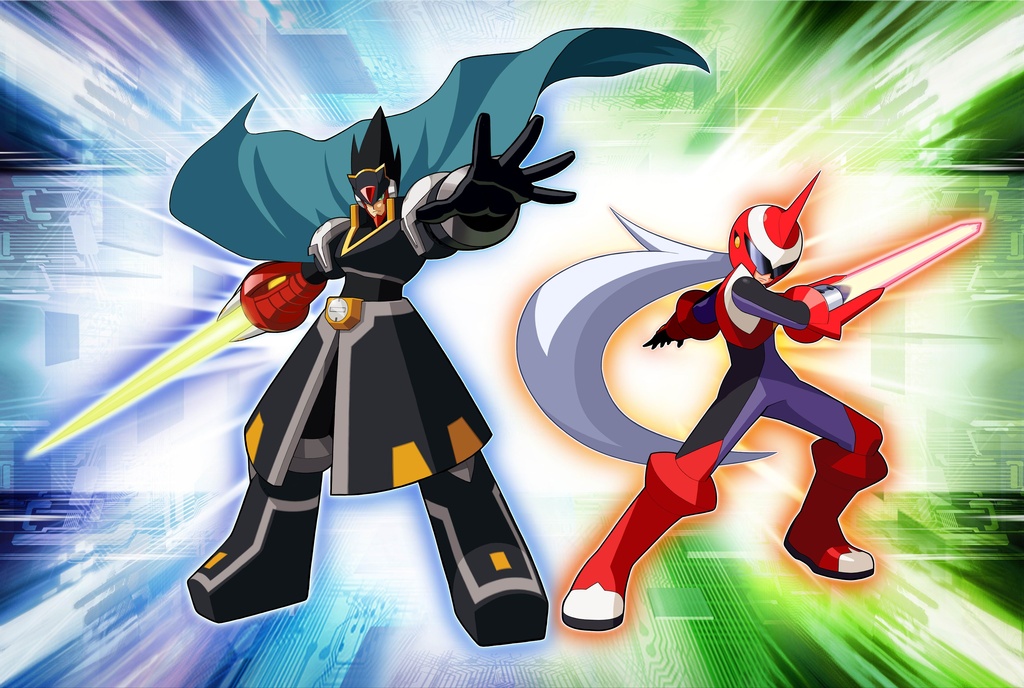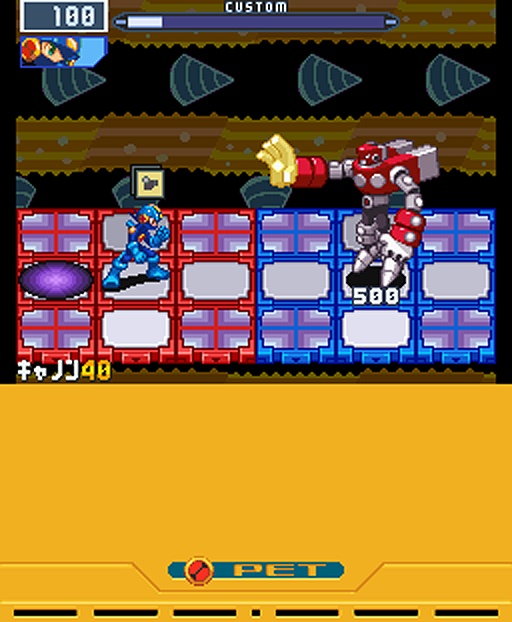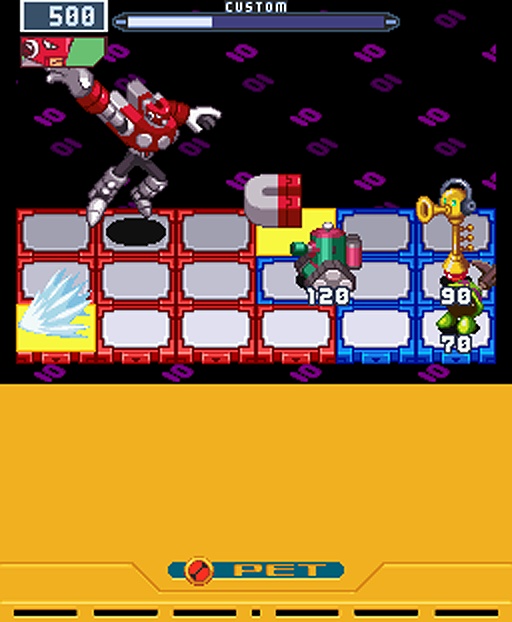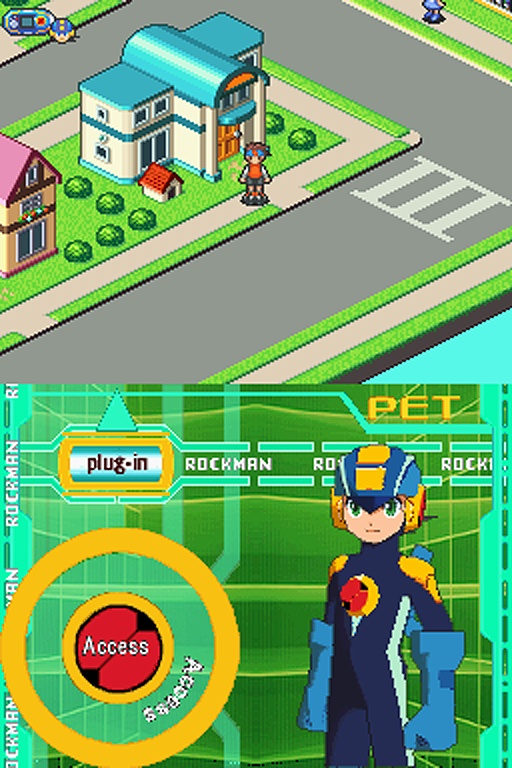While it may be true that Mega Man Battle Network 5: Double Team is merely just an enhanced version of a GBA game that was released a few months earlier, it's also impossible to deny that all of the added map, touch-screen, and Wi-Fi features make the DS game easier to play, and ultimately more enjoyable. If you haven't yet given Capcom's Mega Man-themed role-playing-game franchise a try, now might be the time to finally cut your teeth. And, if you're a longtime fan, you'll appreciate all of the improvements, not to mention the ability to unlock bonuses and transfer chip folders by inserting previous Mega Man Battle Network games into the system's GBA slot.

For the uninitiated, the Mega Man Battle Network series combines traditional role-playing with action-oriented combat. The central idea is that the real world and cyberspace exist as two separate universes. A young boy named Lan wanders around and interacts with people and places in the real world, while his souped-up cell phone, a Navi named Mega Man, explores cyber dungeons in the virtual world and partakes of random battles against evil Navis (called viruses). Often, the things you do in cyberspace will unlock doors or activate machines in the real world, and vice versa. Combat isn't turn-based, like it usually is in role-playing games. Instead, battles happen in real time on a 6-by-3 grid that's split evenly into player and enemy areas. Naturally, you want to deplete their health meters before they obliterate yours.
The unique thing about combat in the Mega Man Battle Network games is that Mega Man's attacks are randomly decided by drawing tiny cards known as battle chips. Five chips are selected at the beginning of each battle, and when they're used, others are drawn to take their places. Some chips are better against certain types of enemies, and some can dole out damage to a whole swath of grid squares. Multiple attacks can be chained together by using chips with the same name or letter designation, and some chips can be combined to create stronger attacks. You can only bring 30 chips into battle with you, so that's where most of the game's strategy comes from: collecting, organizing, and storing useful battle chips in your active folder. In all, there are nearly 300 unique chips to find and collect.
Similar to how Ruby and Sapphire introduced multiple Pokemon battles to Nintendo's Pokemon franchise, Mega Man Battle Network 5 introduces the ability to alternate between and control multiple Navis (in addition to Mega Man) in cyberspace battles and during so-called "liberation" missions. The main difference between the two situations is that you can only bring two other Navis besides Mega Man into cyberspace, whereas in liberation missions you can control as many as six. Liberation missions are basically just turn-based variations of cyberspace levels. Each level is filled with dark panels that block your way to the boss. By using the Navis on your team, your goal is to liberate dark panels until you clear a path. Each dark panel contains a group of viruses--so battles aren't random--but you can only liberate one panel per turn with each Navi. Once all your Navis have been used, your turn ends, and the boss gets its chance to heal its minions or conjure new viruses to stand in your way.
Mega Man Battle Network 5 improves upon Mega Man Battle Network 4 in a myriad of other ways, too. Many of the dungeons in cyberspace now include puzzles and side games, instead of just leading the player toward the exit with a constant flurry of random battles. Battle arenas have a wider variety of terrain, such as rocks and leafy vegetation, and some arenas are split so that enemies are on the left and right sides of the screen while Mega Man is in the middle. Most importantly, dark chips have been made easier to find and use. Dark chips are powerful attack chips that can cause Mega Man to lose HP or turn evil if he uses them too frequently. There are twice as many dark chips now, and they can be collected and put into folders just like regular chips. Previously, the CPU would occasionally just insert a random dark chip into the deck during a battle. It's also possible now to combine a dark chip with a soul Navi chip in order to activate a soul unison attack, which doesn't reflect negatively on Mega Man's HP or personality. Taken together, these changes give players more leeway to collect and use dark chips.

Like most RPGs, Mega Man Battle Network 5 is primarily a dungeon crawler. You'll spend most of your time in the game traveling through cyberspace areas in search of the enemies you need to defeat and items you need to collect in order to advance the story along. The inclusion of multiple Navi battles, liberation missions, and more side games makes that journey livelier than it was in previous games. But the core gameplay still involves a lot of back-and-forth travel and frequent, randomly occurring battles. Like in similarly designed RPGs, the roughly 30-hour trek through the game does feel tedious at times. And, like in any other similarly designed RPG, the story and characters make up for the game's repetitive hands-on aspects. On the one side, you have a group called Nebula trying to take over the world by cornering the market on dark chips. On the other side, you have Lan and his friends trying to stop them. In the middle, you have familiar characters like Mega Man, Protoman, Guts Man, and so forth. If you enjoy the Mega Man universe, you should have enough steam to slog through the game from beginning to end without burning out on cyberspace dungeons.
When Mega Man Battle Network 5 was released for the GBA, two different versions were published: Team Colonel and Team Protoman. Each version had its own unique set of bosses, helper Navis, and exclusive battle chips, but the stories and locations in both games were identical. In order to collect a complete set of battle chips, you had to trade chips between the two different versions of the game. As the name "double team" implies, the DS game packages those formerly stand-alone versions together on a single game card. You can pick which variation you want to play by selecting it from a menu, and, more importantly, you can swap battle chips and Navis from one version to the other simply by going to the in-game chip shop or by using TP chip items to initiate a Navi transfer. That sure beats wrangling two separate GBA systems, two game cartridges, and a link cable.

Apart from combining the two individual GBA games together, the DS version of Mega Man Battle Network 5 also features a slew of enhancements that take advantage of the system's unique hardware features. Players can now access Mega Man's PDA functions and edit battle chip folders using the stylus and lower touch screen. Tapping icons and physically dragging chips back and forth between folders is easier and more intuitive than using the D pad and buttons. The process is also more enjoyable from a conceptual standpoint, since one of the game's underlying premises is that Mega Man exists inside of Lan's PDA. For the first time, players can interact with Mega Man just like Lan does. Another useful change is the ability to display a map on the lower screen while moving around on the upper screen. It was easy to get lost in the GBA game, particularly in some of the larger cyberspace areas, because there wasn't a map to refer to. Just having a map in the DS game is a major improvement.
Trading battle chips and participating in multiplayer battles is also much easier in Double Team, thanks to the DS's Wi-Fi capabilities. Players no longer need to fuss with link cables just to swap chips or compete against friends that have their own copy of the game. Additionally, Capcom has implemented a Wi-Fi tournament mode into the DS game. As many as eight players can get together and participate in elimination-style one-on-one matches to determine the overall winner, who earns a free battle chip for taking the top spot. One especially nifty feature of the tournament mode is that players waiting on standby can choose to watch the current match in progress on their own DS. That's a nice alternative to staring at a static "please wait" screen. While not many players will be able to find three or four people locally that own the game, let alone seven, it's nice that Capcom at least made it possible to get large-scale tournaments going.
Another nice feature is the ability to transfer data, unlock bonus goodies, and power up helper Navis just by loading up the game with another Mega Man Battle Network game in the system's GBA cartridge slot. If you boot up with Mega Man Battle Network 5 in the slot, you'll be able to transfer over your battle chip folder--saving you from hours of repeated legwork. If you insert one of the first four Mega Man Battle Network games, you'll unlock different outfits and starting chips for Mega Man. When you continue to play through the DS version with one of those games in the GBA slot, you'll encounter additional merchants and minigames that aren't normally present, and you'll also discover that certain helper Navis have been powered up during liberation missions. These bonuses may sound paltry and frivolous, but the ability to begin a new game with even a few extra chips, or to start a liberation mission with a stronger Navi, offers a significant head start over the norm.
Taken together, all of the improvements and new features implemented in the DS game do make it worth owning over the older and less pricy GBA game. The core gameplay may not have changed, but being able to find your way around cyberspace and more easily manage chip folders and items ultimately makes it easier to enjoy the game. After all, less time spent wandering around or futzing with menus means more time spent fighting viruses and experiencing story-related events.

Of course, since the DS game is merely an upgraded version of the GBA game, the graphics and audio pretty much reflect what the GBA can do and not what the DS is capable of. Capcom added voice narration to many of the in-game menus and dialogue boxes, which were previously silent in the GBA game, but that's as far as it went to spruce up the game's presentation. For the most part, the three-quarter-view environments are sharp and colorful. Things like doorways, exits, paths, and interface terminals are easy to make out. The character graphics used for the Navis and viruses are fairly large, and fans of the Mega Man franchise will be pleased that they look just like the character sprites that were in the old Super NES Mega Man games. What's not so pleasing is the dearth of animation, particularly during battles. The characters pop instantly from one square to the next on the battle grid, instead of walking, and their bodies transition into attack poses or react to damage in two or three jerky frames. One could argue that the crayon-style colors, goofy portraits, and jumpy two-frame attack animations contribute to the game's unique artistic style. Even so, Capcom could have at least improved the animations or tacked on a few more visual effects for the DS release. As for the audio, major portions of the music and sound effects have simply been recycled from earlier Mega Man Battle Network games. In general, the dramatic melodies, familiar Mega Man themes, and high-tech lasers and explosions fit the action just fine, even though they don't set the bar any higher.
All told, Mega Man Battle Network 5: Double Team toes the line between money-grubbing rehash and legitimate upgrade. Ultimately, the game wins the day because its added features genuinely do make it more user-friendly and enjoyable. Capcom has taken what was already a decent role-playing game on the GBA and has made it better on the DS.